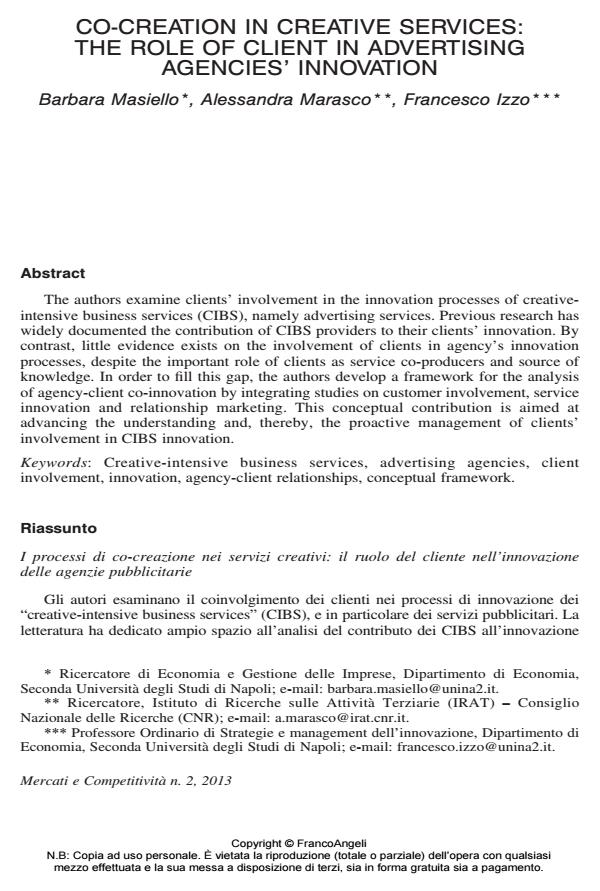CO-creation in creative services: the role of client in advertising agencies’ innovation
Journal title MERCATI & COMPETITIVITÀ
Author/s Barbara Masiello, Alessandra Marasco, Francesco Izzo
Publishing Year 2013 Issue 2013/2
Language Italian Pages 25 P. 131-155 File size 754 KB
DOI 10.3280/MC2013-002007
DOI is like a bar code for intellectual property: to have more infomation
click here
Below, you can see the article first page
If you want to buy this article in PDF format, you can do it, following the instructions to buy download credits

FrancoAngeli is member of Publishers International Linking Association, Inc (PILA), a not-for-profit association which run the CrossRef service enabling links to and from online scholarly content.
The authors examine clients’ involvement in the innovation processes of creativeintensive business services (CIBS), namely advertising services. Previous research has widely documented the contribution of CIBS providers to their clients’ innovation. By contrast, little evidence exists on the involvement of clients in agency’s innovation processes, despite the important role of clients as service co-producers and source of knowledge. In order to fill this gap, the authors develop a framework for the analysis of agency-client co-innovation by integrating studies on customer involvement, service innovation and relationship marketing. This conceptual contribution is aimed at advancing the understanding and, thereby, the proactive management of clients’ involvement in CIBS innovation.
Gli autori esaminano il coinvolgimento dei clienti nei processi di innovazione dei "creative-intensive business services" (CIBS), e in particolare dei servizi pubblicitari. La letteratura ha dedicato ampio spazio all’analisi del contributo dei CIBS all’innovazione dei propri clienti, mentre pochi studi hanno esaminato il processo inverso, nonostante l’importante ruolo riconosciuto ai clienti quali fonti di conoscenza e co-produttori di servizi. Per colmare tale gap, gli autori sviluppano un modello analitico integrando gli studi sul coinvolgimento del cliente, l’innovazione nei servizi e il marketing relazionale. Gli autori forniscono un contributo teorico utile a comprendere meglio e, quindi gestire proattivamente, il coinvolgimento dei clienti nell’innovazione dei CIBS.
Keywords: Creative-intensive business services, advertising agencies, client involvement, innovation, agency-client relationships, conceptual framework.
- Strategie di innovazione nelle imprese creative di servizi Francesco Izzo, Barbara Masiello, in ECONOMIA E DIRITTO DEL TERZIARIO 1/2015 pp.63
DOI: 10.3280/ED2015-001004
Barbara Masiello, Alessandra Marasco, Francesco Izzo, CO-creation in creative services: the role of client in advertising agencies’ innovation in "MERCATI & COMPETITIVITÀ" 2/2013, pp 131-155, DOI: 10.3280/MC2013-002007